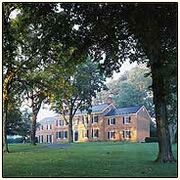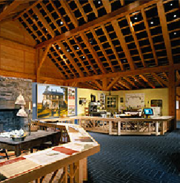- Museum of the Shenandoah Valley
-
Coordinates: 39°11′07″N 78°10′48″W / 39.1854°N 78.1800°W
Museum of the Shenandoah Valley 
Established 2005 Location 901 Amherst Street
Winchester, Virginia 22601
United StatesType Fine Arts, Decorative Arts, History Website www.shenandoahmuseum.org The Museum of the Shenandoah Valley is located at 901 Amherst Street, Winchester, Virginia. The Museum interprets the art, history, and culture of the great valley for which it is named. This regional museum complex includes a historic house dating to the 18th century, six acres of spectacular gardens, and a museum designed by internationally recognized architect Michael Graves. The museum is open year-round, and the house and gardens are open March through November. All are open 10 a.m. to 4 p.m., Tuesday through Sunday; closed Mondays and major holidays. An admission fee is charged.
The Museum of the Shenandoah Valley is dedicated to the art, history, and culture of the Shenandoah Valley. The MSV complex consists of three main components:
Contents
The House
The Glen Burnie Historic House traces its history to surveyor James Wood (?-1759), who settled this land in the early 18th century and donated portions of his land to establish the city of Winchester, Virginia in 1744. His son Robert Wood constructed the central portion of the Glen Burnie Historic House in the 1790s. The house’s ownership passed through several generations of Wood and then Glass families until Julian Wood Glass Jr. (1910–1992), acquired it in 1955. Julian Wood Glass Jr. was the last descendent of James Wood to live in the Glen Burnie Historic House.
Beginning in 1959, and aided by R. Lee Taylor, Glass transformed the house into a country estate, and fashioned the Glen Burnie Gardens. Glass created the Glass-Glen Burnie Foundation prior to his death in 1992, and entrusted the Foundation to open the site to the public as a museum. The Glen Burnie Historic House & Gardens opened to the public in 1998.
Today, the house is presented as it was furnished by Julian Wood Glass Jr. The interior of the house is decorated with fine furniture, decorative arts, and paintings from such artists as Pompeo Batoni, Jean-Baptiste Camille Corot, Martin Johnson Heade, Rembrandt Peale, Severin Roesen, and George Romney. Other objects include a tall case-clock by Goldsmith Chandlee, constructed circa 1795 and the largest collection of works by the Winchester artist Edward Caledon Bruce (1825–1900). Docent-led tours of the house are offered from March through November.
The house is located on the National Register of Historic Places and the Virginia Landmarks Register.
The Gardens
The six acres of gardens surrounding the Glen Burnie Historic House were created beginning in 1956 and evolved over the latter half of the 20th century. Today the museum maintains this living collection in a manner that is sympathetic to the garden creators’ vision for this landscape.
The museum gardens invite discovery and support formal entertaining. Outstanding aspects of the collection include two crab apple Allées, the majestic Grand Allée, and the intimate Pleached Allée. Boxwood plantings factor highly in the landscape and were used to create a Parterre Garden and Knot Garden; the museum is in the process of a boxwood rejuvenation project to revive these and other boxwood plantings throughout the site.
The gardens also contain significant Rose Gardens that contain nearly four hundred fifty individual plants. The Perennial Garden presents flowers planted in mirroring patterns, with varieties of dahlias providing fall interest.
The Vegetable Garden is also interesting, and is planted in a formal pattern that changes annually. Finally, the living collection also includes trout in the Water Garden pond, and Chinese Geese who hold court near the natural stream on site.[1]
The Museum
The Museum of the Shenandoah Valley was designed by architect Michael Graves and opened to the public in 2005. The Museum contains four main galleries:
The Shenandoah Valley Gallery
The broad sweep of Valley prehistory and history is explored in the museum's large Shenandoah Valley Gallery. A number of different exhibition techniques are used here, including multi-media presentations, interactive elements, images, maps, dioramas, and display of decorative arts. Objects on display include furniture, fraktur, silver and other metals, baskets, textiles, paintings, folk art, long rifles, and ceramics, for which the Valley is famous.
The Julian Wood Glass Jr. Gallery
Presents the private collection of one of the most significant collectors in the Valley. On display in the Julian Wood Glass Jr. Gallery are paintings and drawings by such recognized artists as William Merritt Chase, John Constable, John Singleton Copley, Jasper Francis Cropsey, Thomas Gainsborough, Francesco Guardi, Sir Thomas Lawrence, Sir Joshua Reynolds, Gilbert Stuart, and James Whistler; as well as fine examples of 18th and 19th century European furniture and American Federal-period furniture from the shop of John and Thomas Seymour.
The R. Lee Taylor Miniatures Gallery
This gallery presents an outstanding collection of furnished miniature houses and rooms by R. Lee Taylor (1924–2000), who worked with Julian Wood Glass Jr. to create the Glen Burnie Gardens. At the time of his death, Taylor had assembled fourteen completely furnished rooms and houses. On display are five houses and four rooms by R. Lee Taylor showcaseing the work of more than seventy-five miniatures artisans. Also on display are four shadowboxes by the late Valley miniatures artist William P. Massey, who created his work between the 1930s to 1940s.
The Changing Exhibition Gallery
Several temporary exhibitions are presented throughout the year. Currently on view is "American Scenery: Different Views in Hudson River School Painting", through January 23, 2011. The exhibit was developed and toured by the Westmoreland Museum of American Art in Greensburg, PA.
Previous exhibitions have included Civil War maps by Jed Hotchkiss, paintings by Henri Matisse, Pablo Picasso, Garnet Jex, and Pierre Daura; photographs from National Geographic, Shenandoah National Park, the O. Winston Link Museum and of Elvis Presley; a selection of paintings from the Berger Collection at the Denver Art Museum; jewelry, dulcimers, and Valley quilts and chairs.
External links
Notes
- ^ "The Gardens of Glen Burnie". http://www.shenandoahmuseum.org/attractions/gardens/collection.html. Retrieved January 27, 2009.
Categories:- Art museums in Virginia
- Botanical gardens in Virginia
- Museums in Winchester, Virginia
- Houses in Virginia
- Historic house museums in Virginia
- History museums in Virginia
- Michael Graves buildings
- Houses in Winchester, Virginia
Wikimedia Foundation. 2010.



